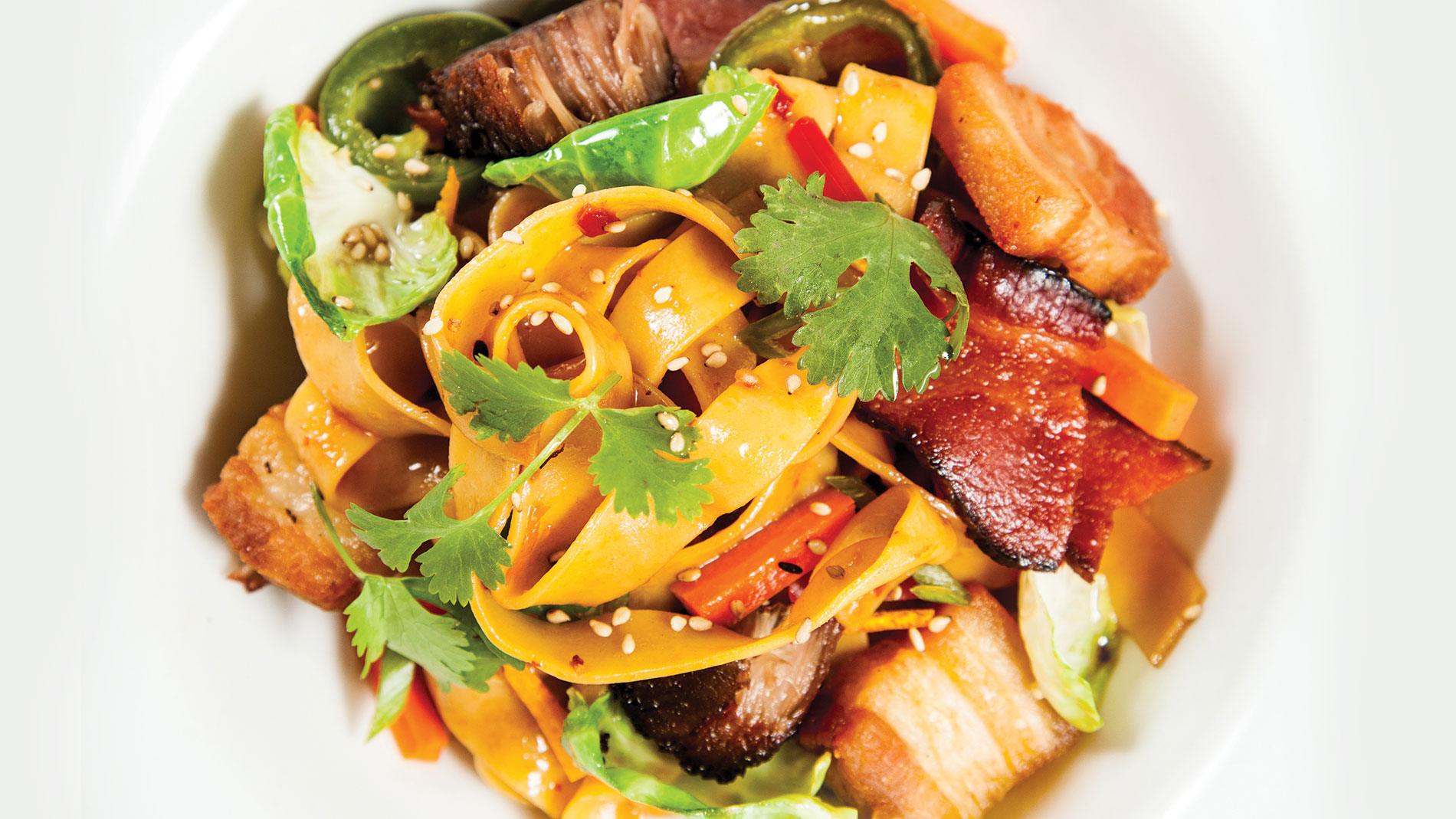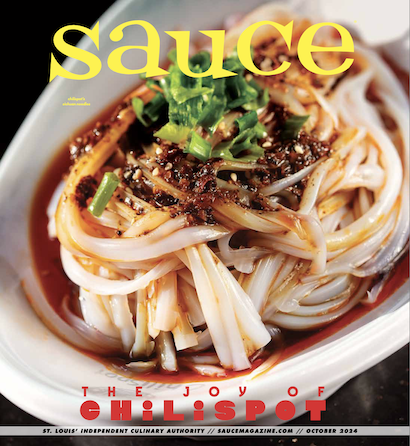St. Louis chefs take inspiration from Hawaii
Editor's note: Barrister’s, Cucina Pazzo, and VB Chocolate Bar have closed.
No U.S. state expresses its cultural mashup through food quite like Hawaii. Native Hawaiians, Chinese, Japanese, Portuguese, Puerto Ricans, Koreans, Filipinos, Samoans, Vietnamese and Thais have all played a role in Hawaii’s rich culinary history. Each ethnicity has its own hallmark ingredients, dishes and traditions. But put them together, stir the pot and add a dash of the mainland – that’s Hawaiian.
The nation’s 50th state is in the midst of its own gastronomic revolution, as everything from fine dining establishments to food trucks are recalibrating the island’s food culture within a more local, sustainable framework. Yet thoughts of Hawaii abound right here in River City, where barges, rather than outriggers, dot our muddy brown “ocean,” er, kai. What does this wave of Pacific cultural transfer look like?
The Hawaiian pasta salad, a periodic special at Barrister’s, is a simple dish of cold pasta with bits of pineapple and ham tossed in a creamy dressing. Chef-owner Jason Tilford explained that the salad is a joke between himself and a line cook at the Clayton bar, which began years ago when the two were discussing the identities of ethnic cuisines. “I said, ‘What’s Hawaiian cuisine?’ He said, ‘Pineapple and ham.’”

When we mainlanders imagine Hawaiian food, we think of pineapple and ham, too – whether on pasta or pizza – but macaroni noodles are just as emblematic of island culture. Although the type of pasta in the salad at Barrister’s varies, when macaroni lands in the pot, that line cook isn’t far off the mark: mac salad – clinging heavily with mayo and boosted with celery, onion, carrots or potatoes – is a staple side dish on plate lunches in Hawaii. My brother José Figueras, who has called Honolulu home for the last 18 years, deemed mac salad “the epitome” of Hawaii. “There’s macaroni salad with everything,” he said. His girlfriend, Kelly Tatom, a native of the Big Island, agreed. “One scoop mac salad, two scoops white rice and whatever the meat dish is – that’s the old-school way,” she said.
A loco moco is to Hawaii what a slinger is to St. Louis. Often late-night sustenance (but available around the clock), the loco moco is a bowl of white rice topped with a hamburger patty followed by a sunny side up egg or two, all smothered in brown gravy. That’s how it comes when you get it at Zippy’s, Hawaii’s version of Denny’s, and pretty much any mom-and-pop diner on the islands. When you order it at Cleveland-Heath in Edwardsville you get the same, plus pineapple chunks and, yes, Spam.
Cleveland-Heath executive chef and co-owner Ed Heath credited his reach for the salty, processed canned meat to Tom Wong, his former instructor at Napa Valley’s Culinary Institute of America. “He’s a big fan of the novelty of Hawaiian,” said Heath. “Everything we did, over half the recipes were with Spam.”
But it’s no mere novelty. James Wong (no relation to Tom), garde manger chef at 360 Lounge downtown and a native of Hawaii, attested to Spam’s supreme place in Hawaiian culture. “We make sushi out of it. We have carving contests with it,” said Wong with an air of pride.
Yet Hawaiian cuisine isn’t just about employing specific ingredients like Spam or macaroni. It’s also about a style of combining cuisines, be they from the East or West. “Japanese food in Japan isn’t what you get in Hawaii,” Tatom said. “There are lots of food backgrounds, and you put them into one dish.” She could have dubbed that “fusion.” Instead, Tatom offered a linguistic simile, appropriate for a state where Pidgin, or Hawaiian Creole, still weaves its way into local-speak: “It’s almost like a new language.”

Creating a new food language is precisely the idea behind the food at Cucina Pazzo in the Central West End. Before returning to St. Louis in 2010, Pazzo executive chef Justin Haifley spent a dozen years island-hopping while working for famed Japanese-American chef Roy Yamaguchi, owner of Roy’s chain of restaurants and pioneer of a 1990s food movement known as Hawaiian Regional Cuisine.
One dish on the Pazzo menu that speaks Hawaiian is the JH Chopstick Pig Pasta. A tangle of house-made tagliatelle is tossed in Brussels sprouts, wok vegetables and a medley of pork cuts – pancetta, crispy pork belly, double-cut bacon and ginger-soy-scented Kalua pork. (The latter is traditionally cooked in an earthen pit called an imu. They settle for oven-braised at Pazzo.) But why the Italian-Oceanic handshake?
“It’s called Crazy Kitchen,” remarked Haifley, citing the English translation of the restaurant’s name. His goal: to make pasta dishes that are decidedly different, where purely great taste trumps purity of origin. “Even though it’s not Italian, it’s good and unique,” he said of the pork-laden pasta.
Haifley pointed out that his spicy pasta sauce holds a lot of Japanese influence (Sriracha, sweet Thai chile sauce, soy sauce, eel sauce, onion, garlic, ginger and sesame chile oil), yet he’s content to consider the composed dish Hawaiian in style. “You say ‘Japanese’ and people think weird flavors. You say ‘Hawaiian’ and that’s fun.”
Fun is key when it comes to a food-centric celebration like a luau. VB Chocolate Bar owner Conor Van Buskirk decided to host one of these Hawaiian-style feasts in June at his cafe in Cottleville. Inspired by a trip he and his wife took to Hawaii to celebrate their wedding anniversary, Van Buskirk peppered his menu with ingredients he encountered regularly during his island getaway. “I saw a lot of coconut, macadamia, guava and lilikoi, otherwise known as passion fruit,” he recalled. Those pervasive tropical fruits and nuts became a showstopper in his artisan chocolates. Lucky for us, those creamy exotic fruit truffles and decadent nut barks are still on the VB menu – long after the flames of the tiki torches went out. Mahalo!
Tags : Places, Restaurants






